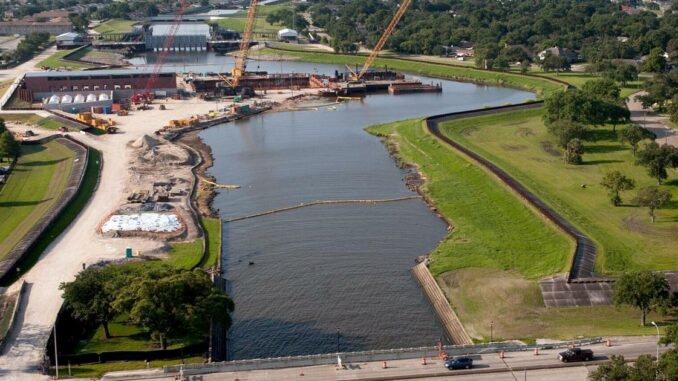
The inspections are requiring the installation of stoplogs to block water entering each bay where the pumps are located within the stations, so the pumps, most of which usually are under water, can be uncovered and examined.
Temporary repairs are expected to be complete before June 1.
But the Corps also has begun what it terms a “long-term repairs” strategy aimed at a more comprehensive review of whether the design of the pumps was deficient, including a review of the ability of the metals used in their construction to withstand corrosion throughout their 35-year design life.
A contract for that review has not been finalized, but is expect to take at least two years, and will require the identification of a funding source.
An example of an alternative use of temporary pumps at the 17th Street Canal that might be used if pump stations become inoperable because of corrosion. (Army Corps of Engineers)
The Corps also is evaluating alternatives for removing water from the canals in the event pump capacity at individual stations drops below what is needed during hurricanes. Water levels in each canal are limited to no higher than 8 feet above sea level to protect floodwalls.
One alternative would simply delay when the gates at canals are closed, based on water levels in Lake Pontchartrain, which are an average 1 foot above sea level without storms.
At London Avenue, the gates would be closed when lake levels are 4.5 feet and rising, instead of 3 feet; they would be closed when levels are at 5 feet and rising, instead of 4 feet, at the 17th Street and Orleans Avenue canals.
A second alternative would include the installation of temporary pumps at one or more of the stations, where they would suck water out of the canal and pump it over the gate structure into the lake. A third alternative could include both options.
“In the short term, we want to make sure that all the stations are operating during this hurricane season,” said Corps spokesperson Ricky Boyett. “In the long term, we are leveraging the entire Corps to ensure we can bring these pumps to their specified design life. When we’re looking at the long-term alternatives, we will undertake that work outside the hurricane season.”

Leave a Reply